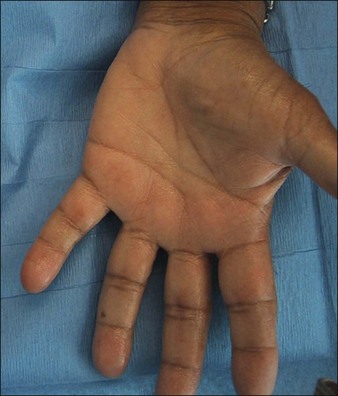24 Palmo-plantar hyperhidrosis
Summary and Key Features
• Palmar and plantar hyperhidrosis cause a significant impact on the quality of life for people who suffer from the disorder
• Botulinum toxin type A can produce hypohidrosis on the palms and soles for up to 6 months
• Ice or cooling devices are well-tolerated modes of anesthesia for the hands; however, regional nerve blocks are recommended prior to plantar injections
• Injections should be spaced 1–1.5 cm apart with 2–3 U of botulinum toxin A per injection site on average
• Success rates reach 90% for palmar hyperhidrosis with variable success for plantar hyperhidrosis despite similar injection techniques
• Postoperatively, patients may experience some weakness of thumb–index finger-pinch strength, which returns after 2–3 weeks; if injections are placed superficially and spaced properly, however, most will not
Patient evaluation
Most patients who present with palmar HH have had the condition since childhood or early adolescence with no known cause and report ‘sweaty palms’ that cause them social embarrassment. Solish & Haider reported evidence suggesting that an autosomal dominant inheritance pattern with variable expressivity such that a child born to a parent with palmar HH has a 25% chance of developing the disorder as well. Patients will go to great lengths to avoid shaking people’s hands and often keep their hands in their pockets. The hyperhidrosis can be so severe as to cause actual physical dripping and maceration and peeling of the skin itself (Fig. 24.1). Similarly, patients with plantar hyperhidrosis will report the need to change socks frequently or that they ‘slip’ in their shoes while walking. Interestingly, a study by Lear and colleagues suggested that spontaneous regression might occur over time as there is a low prevalence of the disorder in the elderly population. It is important for the physician to keep in mind the severe psychological impact HH has on patients, many of whom do not seek treatment due to embarrassment and yet decrease their leisure activities and suffer from depression because of it.
Prior to treatment, it is important to take a careful clinical history to ensure that the patient suffers from primary, not secondary, hyperhidrosis. In secondary hyperhidrosis, medications or systemic health problems can be responsible for sweating (Box 24.1) and the condition is usually generalized. If there is a suspicion of secondary hyperhidrosis, a complete blood count, fasting glucose level and thyroid function test are preliminary laboratory tests to be ordered.
Box 24.1
Select causes of secondary hyperhidrosis
 Febrile illness (e.g. chronic infections)
Febrile illness (e.g. chronic infections)
 Endocrine or metabolic condition (e.g. thyroid dysfunction, diabetes mellitus, menopause, pregnancy)
Endocrine or metabolic condition (e.g. thyroid dysfunction, diabetes mellitus, menopause, pregnancy)
 Neurological disorder (e.g. spinal cord injury, Parkinson disease, stroke)
Neurological disorder (e.g. spinal cord injury, Parkinson disease, stroke)
 Cardiovascular disorder (e.g. heart failure)
Cardiovascular disorder (e.g. heart failure)
 Medication use (e.g. antidepressants, antiemetics)
Medication use (e.g. antidepressants, antiemetics)
 Substance abuse (e.g. drug withdrawal, alcohol abuse)
Substance abuse (e.g. drug withdrawal, alcohol abuse)
 Neoplastic disease (e.g. pheochromocytoma, carcinoid tumors, Hodgkin lymphoma)
Neoplastic disease (e.g. pheochromocytoma, carcinoid tumors, Hodgkin lymphoma)
Scoring the impact of hyperhidrosis on the patient’s quality of life is important as well, not only to gauge treatment success but also to aide in obtaining insurance approval for treatment. The Hyperhidrosis Disease Severity Scale (HDSS) is a quick diagnostic tool that the practitioner can administer during the examination and was found by Solish and colleagues to be a reliable means of assessment (Table 24.1). HDSS scores should be followed to guide the choice of treatment and to determine whether treatment has made an impact (success should be considered a reduction in HDSS of 1 or more).
Table 24.1 Hyperhidrosis disease severity scale
| Patient response | Score | Clinical interpretation |
|---|---|---|
| My sweating is never noticeable and never interferes with my daily activities | 1 | Mild |
| My sweating is tolerable but sometimes interferes with my daily activities | 2 | Moderate |
| My sweating is barely tolerable and frequently interferes with my daily activities | 3 | Severe |
| My sweating is intolerable and always interferes with my daily activities | 4 | Severe |














